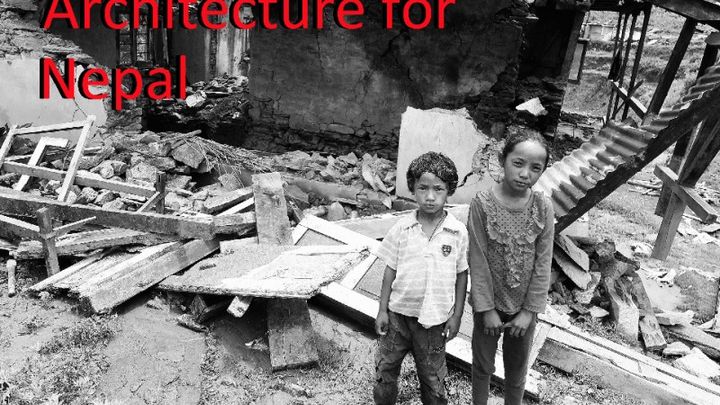
Architecture for Nepal
Donation protected
My name is John Ullman. I'm an architect, trained at Pratt Institute in New York City. While I have practiced for many years in New York, my passion is to contribute design to create a positive impact on needy people--especially children--in the Himalayas.
My first project, Architecture for Tibet (architecturefortibet.org), led to the creation of an Academic Center at the Manjushree Orphanage in Tawang, India. Now I've turned my attentions to Nepal.
You probably know that a 7.8 magnitude earthquake hit Nepal on April 25th. An estimated 8,000 lives have been claimed. Beyond the human loss, entire villages have crumbled away before the survivors’ eyes. National Emergency Operation Centre Nepal [ULR] estimates the number of homes completely destroyed at 488,789, with 267,477 unsafe to inhabit. At this time, the best things we can do is to help these needy people create suitable temporary buildings.
While Nepal is no longer in the news headlines and the burst of enthusiasm to help has now faded in the world’s collective conscious, our effort, “Architecture for Nepal and Tibet,” is alive. Our contribution will not only bring buildings to locals in dire need, but will help influence others to keep the flame of compassionate action alive – in a small way if necessary, in a big way if possible.
Nepal’s struggle is ongoing and the re-building effort will continue for years to come. The temporary buildings can and will be built with a long-term approach in mind: Our team of local professional and enthusiastic volunteers aim to carry out reconstruction after this thinking process finds a balanced solution for bringing a sustainable rebuilding program based on traditional building. And empowering villagers to be self-sufficient is a more cost-effective and longer-lasting solution than building too quickly.
Involving local people in the decision making process about the designs is key. Education on proper building techniques will enable the locals to understand, believe in and implement buildings that are safe. They then can oversee the construction themselves and enjoy a sense of accomplishment.
Our reconstruction model depends on local skills in the interest of maintaining local vernacular, as opposed to possible business exploitation. However, one should also expect certain aspects of prefabrication and standardization to be used.
This earthquake has birthed an opportunity to empower people to build and be self-sufficient from generation to generation, far into the future. It is our hope that the obliteration of the vernacular via readymade building products from international markets will fade away in light of sound planning with local input.
Above all, the project is a reflection of our good wishes, consistent with our ethos of love and compassion.
My first project, Architecture for Tibet (architecturefortibet.org), led to the creation of an Academic Center at the Manjushree Orphanage in Tawang, India. Now I've turned my attentions to Nepal.
You probably know that a 7.8 magnitude earthquake hit Nepal on April 25th. An estimated 8,000 lives have been claimed. Beyond the human loss, entire villages have crumbled away before the survivors’ eyes. National Emergency Operation Centre Nepal [ULR] estimates the number of homes completely destroyed at 488,789, with 267,477 unsafe to inhabit. At this time, the best things we can do is to help these needy people create suitable temporary buildings.
While Nepal is no longer in the news headlines and the burst of enthusiasm to help has now faded in the world’s collective conscious, our effort, “Architecture for Nepal and Tibet,” is alive. Our contribution will not only bring buildings to locals in dire need, but will help influence others to keep the flame of compassionate action alive – in a small way if necessary, in a big way if possible.
Nepal’s struggle is ongoing and the re-building effort will continue for years to come. The temporary buildings can and will be built with a long-term approach in mind: Our team of local professional and enthusiastic volunteers aim to carry out reconstruction after this thinking process finds a balanced solution for bringing a sustainable rebuilding program based on traditional building. And empowering villagers to be self-sufficient is a more cost-effective and longer-lasting solution than building too quickly.
Involving local people in the decision making process about the designs is key. Education on proper building techniques will enable the locals to understand, believe in and implement buildings that are safe. They then can oversee the construction themselves and enjoy a sense of accomplishment.
Our reconstruction model depends on local skills in the interest of maintaining local vernacular, as opposed to possible business exploitation. However, one should also expect certain aspects of prefabrication and standardization to be used.
This earthquake has birthed an opportunity to empower people to build and be self-sufficient from generation to generation, far into the future. It is our hope that the obliteration of the vernacular via readymade building products from international markets will fade away in light of sound planning with local input.
Above all, the project is a reflection of our good wishes, consistent with our ethos of love and compassion.
Organizer
John Ullman
Organizer
New York, NY